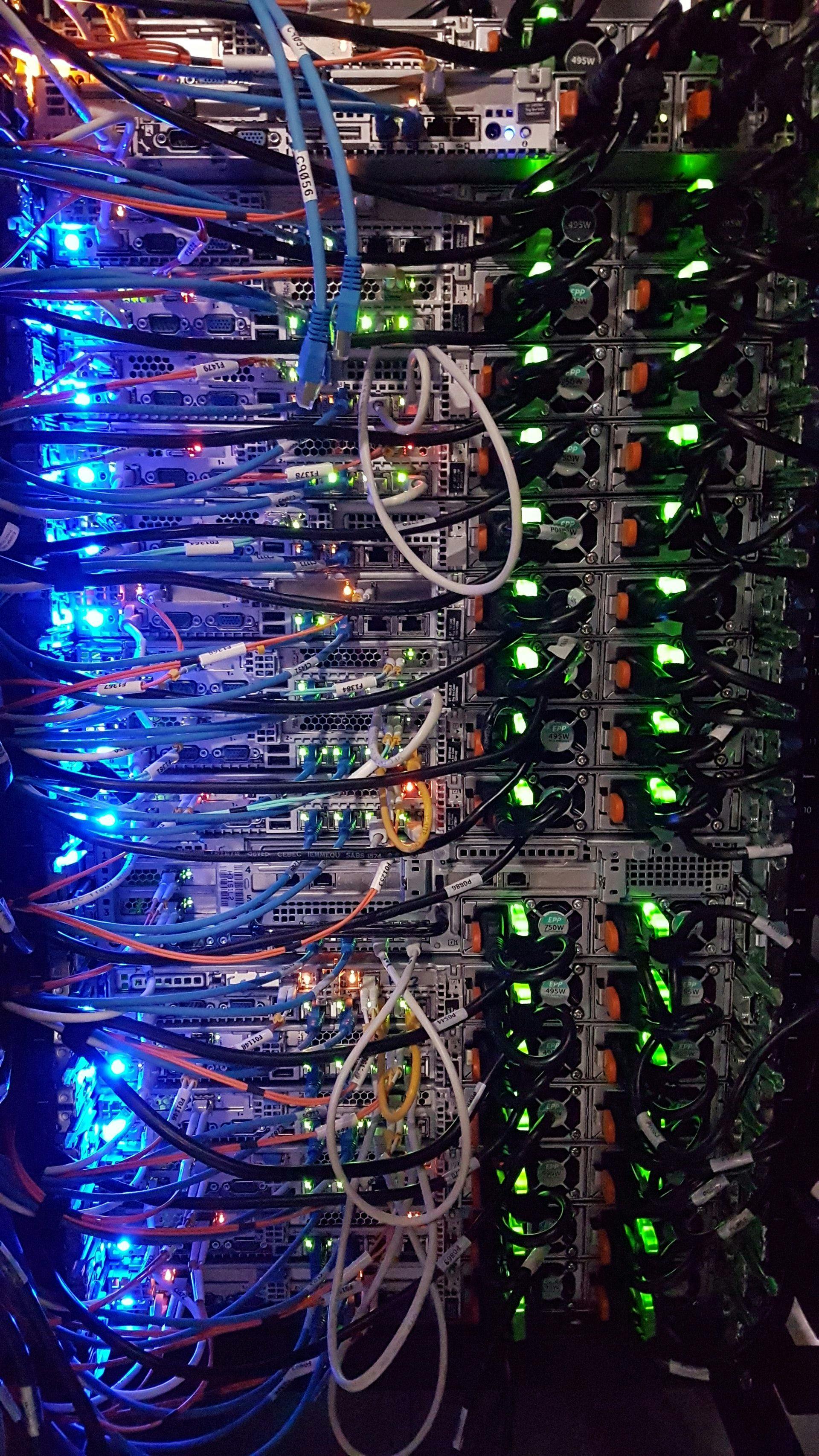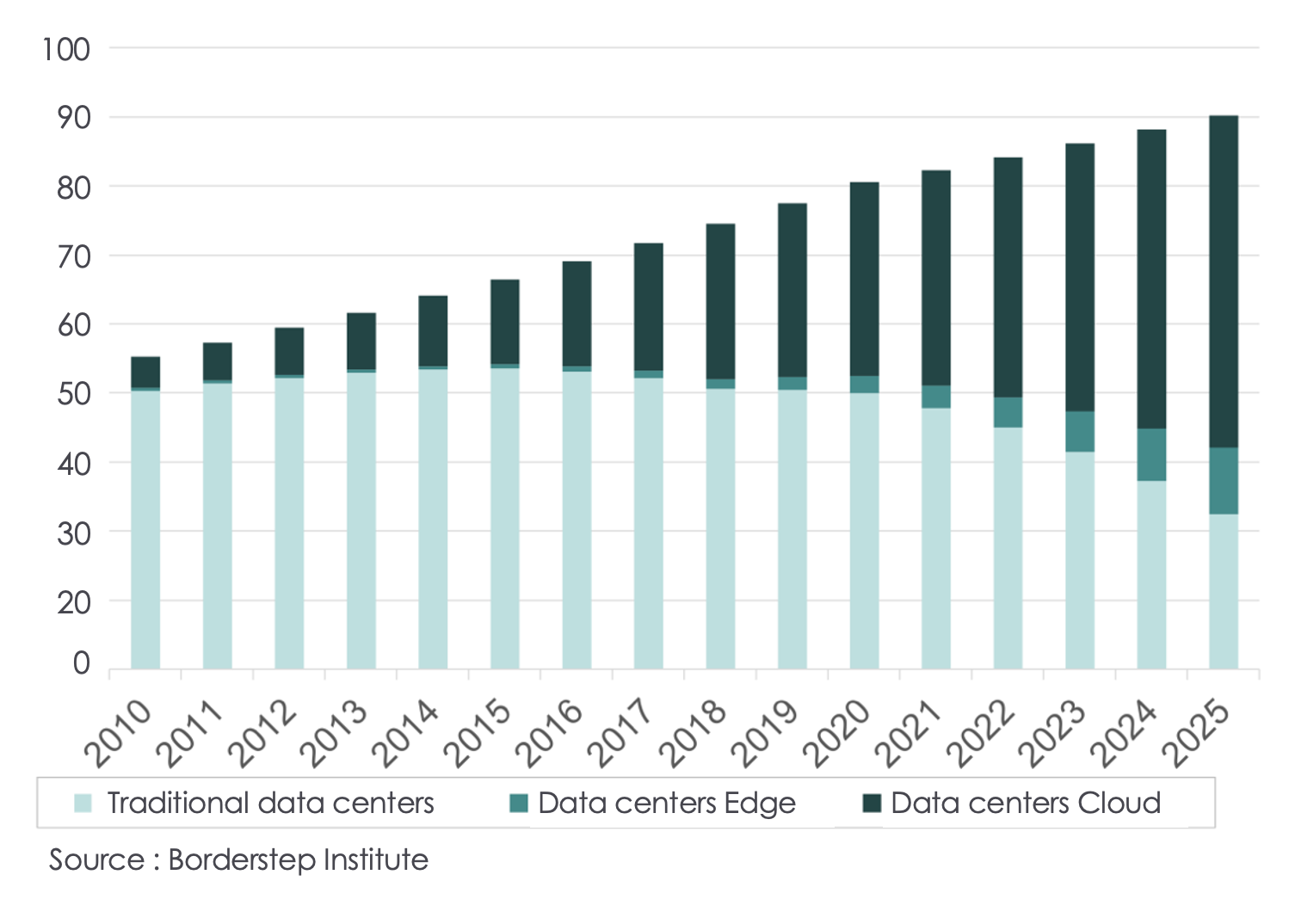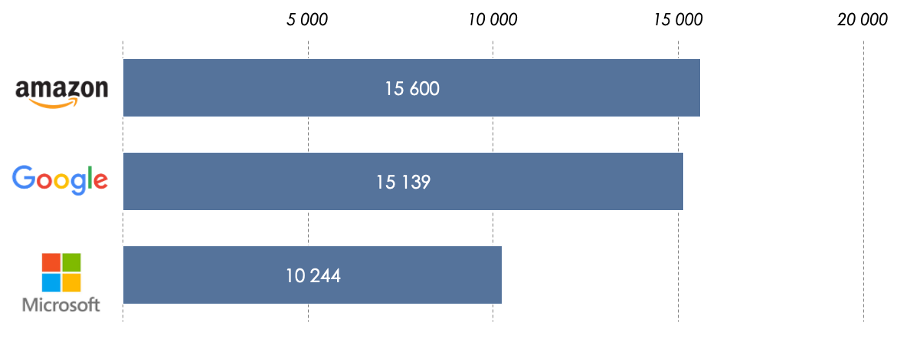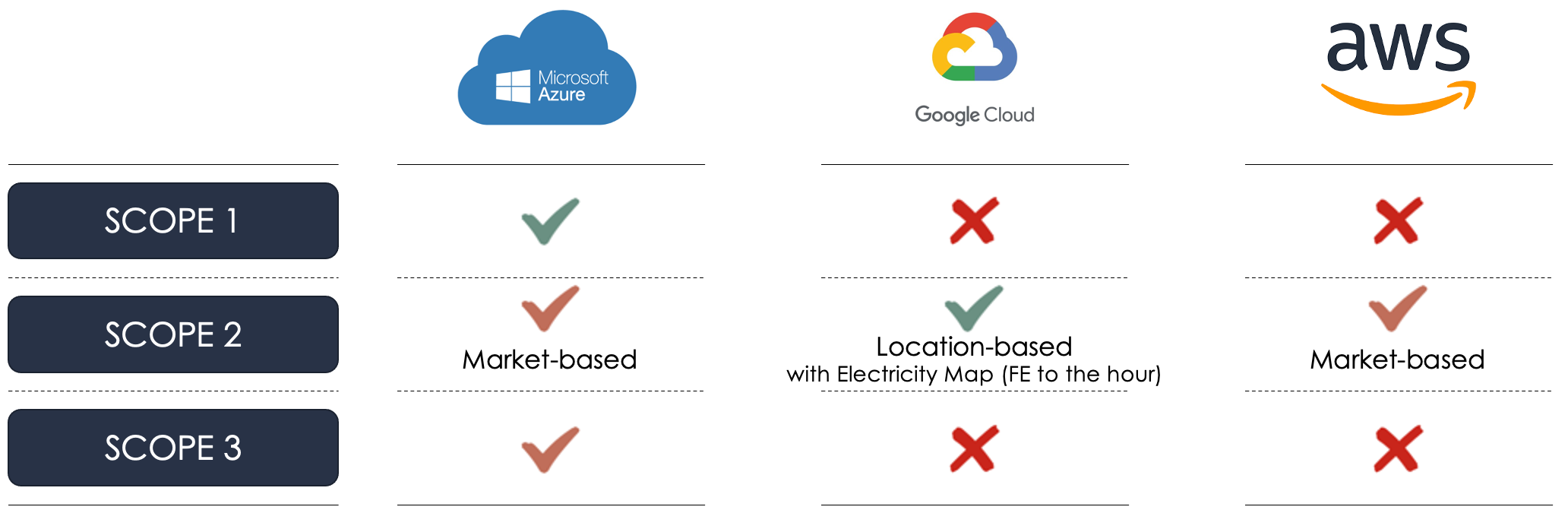Cloud carbon footprint: Do Amazon, Microsoft and Google have their head in the clouds?
The growing use of digital services is now affecting the global evolution of energy consumption and greenhouse gas (GHG) emissions. Between 2013 and 2017, the sector’s energy consumption grew by 50% [1], now representing between 6% and 10% of the world's carbon-intensive electricity consumption[2]. Data centers are essential links in the digital value chain for data use and storage and are growing in an exponential way [3]. However, the servers that make up these centers require a significant amount of electricity to operate. [4] Their manufacture also requires a high consumption of raw materials with numerous environmental impacts. As digital giants, do the hyperscalers, Amazon, Google and Microsoft take these environmental issues into account? How can we understand and analyze their communication on climate?
Historically hosted in the companies’ headquarters that use them (on premise solutions), data centers have been pooled by dedicated operators to whom companies and organizations now rent computing power and storage space.
The specificity of cloud services, compared to ‘traditional’ data center digital services, is the ability of client organizations to apparently free themselves from physical server needs. To put it simply, we can distinguish between:
- on-premise data centers, where the servers are owned by their users,
- traditional data centers for which customers rent physical machines that are dedicated to them,
- cloud data centers.
In the cloud, the machines in the different sites of the same operator are shared. The operator optimizes its physical machines by exploiting them to their full capacity. Customers’ uses are not attached to identified physical machines but are based on virtual machines allowing a greater variety in the range of services from which the uses of the Cloud benefit. Customers pay for their service on a per-use basis, which provides them flexibility and prevents them from having to anticipate their needs. These advantages explain the popularity of cloud services, which should continue in the coming years.
As the cloud grows and becomes dominant in the growing digital data management market, it is important to understand whether cloud providers are controlling the carbon footprint of their services and contributing to the goal of global carbon neutrality.
The three largest cloud providers, which are also known as hyperscalers due to their size and growth, are: AWS, Azure, and Google Cloud [6]. Are the communication and strategy of these companies on climate issues relevant to the objective of keeping global warming below 2°C?
‘Net Zero’ objectives create the illusion of a carbon neutral company concept persist
The first observation is that the three parent companies of the cloud providers analyzed communicate widely on "net zero" objectives, over various time horizons. More generally, this climate communication strategy (based on the achievement of immediate or future carbon neutrality by an individual company) is used by many firms However, these statements reflect realities that are more or less relevant regarding the climate crisis.
- Google, renamed Alphabet in 2015, has considered itself carbon neutral (for all its activities) since 2007[7], thanks to the purchase of carbon credits for its operational emissions [8]. It recently decided to extend this objective to its entire carbon footprint by 2030, considering the upstream and downstream emissions of its operations.
- Through The Climate Pledge, Amazon wants to reach the ‘Net-Zero Carbon’ goal by 2040 [10]. This objective would correspond to removing from the atmosphere, in 2040, as much GHG as the company has emitted in the year.
- Microsoft is committed to being ‘carbon negative’ [12], i.e. removing more carbon than it emits [13].
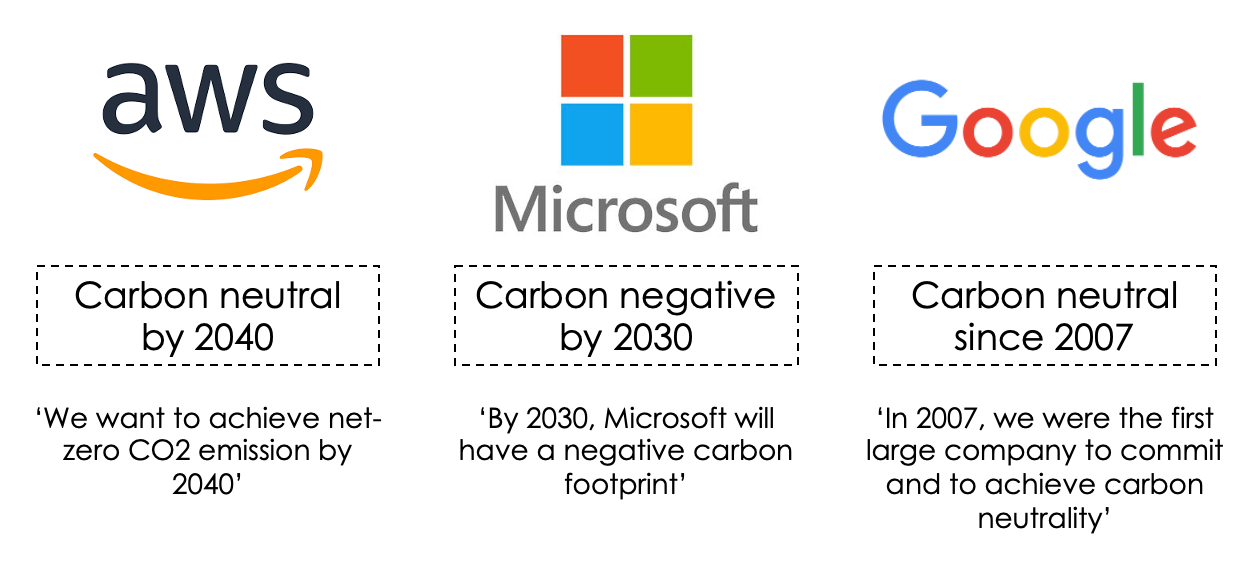
The terms ‘neutrality’, ‘net zero’ and ‘carbon negative’ suggest that if a company generates as many emissions as it absorbs, it simply cancels its carbon footprint, as if the greenhouse gas emissions linked to its activity had disappeared. That amounts to considering that the activity of these companies no longer contributes to the acceleration of the climate shift, and therefore that all climate impacts and transition risks have disappeared. Unfortunately, this view has no scientific basis and does not support climate action.
From a scientific point of view, carbon neutrality cannot be defined at a company level [14], and even less at a product or service level. Only on a global scale can the balance of physical carbon flows (in emission and absorption) be observed, resulting in a stabilization of the atmospheric concentration of GHG. In practice, it is impossible to transcribe this global objective to the scale of a company by a simple set of additions and subtractions.
Therefore, with the help of several dozens of partner companies, Carbone 4 has steered the development of the Net Zero Initiative framework, which enables a company or organization to understand how to maximize its contribution to achieving global carbon neutrality. Sequestered carbon is obviously taken into account, but it is considered to be non-fungible with induced emissions.
Thus, Microsoft, Alphabet or Amazon cannot be carbon neutral, even less carbon negative, regardless of the organizational or operational perimeter. Nevertheless, they can - and should - contribute to global carbon neutrality, in several ways.
Behind the neutrality objectives, the three parent companies have decided to act on increasing carbon sinks:
- By purchasing carbon credits: in 2020, Google purchased 1.2 MtCO2e of carbon credits [15]. Since the beginning of the fiscal year, Microsoft has contracted for nearly 1.5 MtCO2e [16].
- Or by financing non-labeled projects like Amazon, which has committed $10 million to help forest owners sequester CO2 [17].
To achieve global carbon neutrality, the development of sequestration will be essential. Thus, the three cloud giants are putting resources, of varying degrees of importance, into what the Net Zero Initiative has called ‘increasing carbon sinks’, or Pillar C. However, contributing to global neutrality also requires acting very strongly on the other two pillars, which aim towards the reduction of global emissions.

The company must first reduce its own direct and indirect emissions (pillar A), then help others reduce their emissions (pillar B). The second category corresponds to the sale of decarbonizing products and solutions (i.e., those that reduce - in absolute terms - the emissions of customers) and, under certain conditions, the financing of low-carbon projects outside the firm’s value chain.
However, for the time being, the efforts undertaken by Google, Amazon and Microsoft do not lead to a sustainable reduction of their emissions in absolute terms [18] (pillar A), and these companies have not published a convincing demonstration of the reduction of their customers' emissions, also in absolute terms, thanks to the services provided (pillar B).
As a first step, it would be necessary for these companies to develop and implement an ambitious action plan to reduce their emissions in absolute terms. Currently, their reduction strategy is based mainly on the use of renewable energy.
Reduction targets are mainly based on low carbon electricity, which is obscuring the range of possibilities
At both the parent company and cloud service provider levels, electricity procurement is a major issue for Alphabet, Amazon, and Microsoft. Indeed, data centers require a lot of energy to run the servers and to cool them. Naturally, these three companies are seeking to use low-carbon and renewable energy sources (RE) to cover their own consumption [19].
Three methods are traditionally used to claim the use of renewable electricity to power the company's operational activities:
- the purchase of RE Guarantees of Origin (GO) via a market system
- financing additional RE capacity via a long-term contract (Power Purchase Agreement - PPA) with a producer of RE electricity (without necessarily having a physical link between the financing company and the location of the new capacity)
- the creation of its own renewable energy production fleet.
In the first two cases, the company continues to be supplied by the same physical network as before. Therefore, it contractually claims to be purchasing low-carbon electricity, but physically, the CO2 emissions associated with its consumption actually depend on the electricity mix of the network that supplies its facilities [20].
Although cloud providers are among the main buyers of "renewable" electricity, such claims are not grounded in any real physical basis.
To purchase these volumes of electricity labeled as renewable, the 3 players are increasingly resorting to PPAs [22], which allow them to develop additional renewable energy production capacities. However, there is no guarantee of spatial and temporal consistency [23] between the green electricity purchased and the electricity consumed by the infrastructure. There is no guarantee that these additional RE capacities will systematically replace fossil fuel capacities. It can be added to fossil fuel capacities or replace other low-carbon capacities.
Moreover, market-based reporting [24] allows Amazon, Alphabet and Microsoft to reduce their scope 2 emissions by ‘neutralizing’ the emissions of the kWh consumed [25]. It is no longer necessary to monitor energy consumption and to activate energy efficiency and sobriety levers to reduce emissions. The need to reduce energy consumption cannot simply be concealed by a methodological trick that is based on the same scientifically flawed reasoning as ‘neutrality’ in terms of emissions. These companies have even more reasons to work on the efficiency of their energy use since it represents a major cost item for them.
Google’s carbon-free electricity
By 2030, Google wants to be (contractually) supplied with carbon-free electricity 24/7 to cover its own consumption. Google defines ‘carbon-free’ as follows: ‘We define carbon-free power as any type of electricity generation that does not directly emit carbon dioxide. This includes renewables like solar, wind, geothermal, hydro and biomass, as well as nuclear power.’ However, these means of production emit GHGs, whether at the time of their construction, their installation, or their end of life. Rigorous accounting must consider the emissions induced by renewable energies. This makes it possible to really measure the physical impact of energy use. For instance, in 2019, Google's electricity consumption was approximately 12 TWh [26]. Even if this electricity were to come from 100% solar photovoltaic energy [27] via installations physically connected to Google's servers, which is not the case, this consumption would represent 530 ktCO2e, or roughly the emissions of a country like the Seychelles in 2016.
Furthermore, by focusing on their direct electricity consumption, these players forget a significant part of their carbon footprint: the manufacturing and operation of the equipment that is necessary for the service to be provided. Servers are necessary of course, but not sufficient. Indeed, there is no cloud service without an Internet network (which must be built and powered), without terminals (connected screens, computers, smartphones) at the customer's locations.
However, few cloud players publish figures for these other items that are essential for the system to work, which by construction prevents them from thinking more globally about its role. Just by limiting themselves to their own fleet of machines, these companies could communicate on their progress concerning the extension of the life of servers, reconditioning or reuse, limiting redundancy, R&D projects with server manufacturers...
Finally, it seems that these companies above all consider their contribution to carbon neutrality via the financing of external projects concerning electricity or the development of forests, rather than through an in-depth transformation of their activity and their organization.
Regardless of their potential need to reduce energy, raw material and resource consumption, cloud providers claim that the cloud is inherently more efficient than traditional solutions. But is this really the case?
A supposedly better carbon performance of the cloud
The three firms studied rely on several publications [28],[29],[30] to justify that, for a comparable use, the use of their cloud platforms emits less than the use of on premise servers, i.e. hosted within the companies. The arguments put forward are the following:
- By sharing machines, hyperscalers use them almost constantly at their maximum capacity. However, in the on-premise reference situation, the servers are used much more frequently under their nominal capacity. The cloud would therefore lead to a material savings (fewer machines needed for the same requirement) and energy savings (because the machines do not necessarily consume much more if they are working at full capacity).

- Specialized in data center management, the three cloud giants claim to manage the energy consumption of their infrastructure more efficiently than on-premise solutions. In fact, they display the lowest PUE (Power Usage Effectiveness, which compares the total energy consumption of the data center to the energy consumption of the servers only) in the market. Especially Google, which was the first to post a record PUE of 1.1[31].
- They use more renewable energies to power their servers (this point having been discussed above, we will not discuss it further here).
While the arguments of cloud providers are based in reality, they are not sufficient to conclude that moving to the cloud necessarily leads to a lower digital carbon footprint in absolute terms:
- The use of the cloud creates a rebound effect: by paying a posteriori according to usage, cloud customers are under the impression of having unlimited capacity while no longer having as much control over their data consumption as they no longer manage capacity a priori. More generally, the cloud is as much a response to firms’ digital strategy, which is based on a strong inflation of processed data, as it is a response to limit the impact of this inflation.
- Redundancy on the cloud is probably more important than in traditional solutions. This redundancy is partly driven by cloud providers who want to improve the quality of their services.
In order to meet their customers' expectations in terms of controlling their emissions, cloud providers are making information available - as well as visualization platforms - that allow their customers’ to understand some of the greenhouse gas emissions of the services used. Not only do the coverage and calculation methodologies vary greatly from one player to another, but above all they lack overall relevance because they are based on a partial coverage and/or use an inappropriate emission factor (market-based, see above) for the electricity used.
Google Cloud and Azure (Microsoft) offer tools for (partially) managing the carbon footprint of their services. For example, they give or will soon give their customers the possibility to choose the location of their servers according to the carbon intensity of the local electricity. Microsoft allows its customers to schedule the startup and shutdown of their machines. Google Cloud, via an application called Active Assist, identifies underused modules to help customers optimize their resources.
Amazon's, Microsoft's, and Google's purchases of labeled renewable energy and energy efficiency efforts will not be enough to reduce emissions from their operations. To be aligned with the Paris Agreement, these companies should be leaders in creating a new business model that does not encourage overconsumption of resources. This approach would be part of a new global strategic positioning to contribute to global neutrality. However, their customers also have a role to play to implement sufficiency measures, in an effort to bring their digital carbon footprint in line with a 5% annual decrease in global emissions.
Contact us
Contact us about any question you have about Carbone 4, or for a request for specific assistance.
